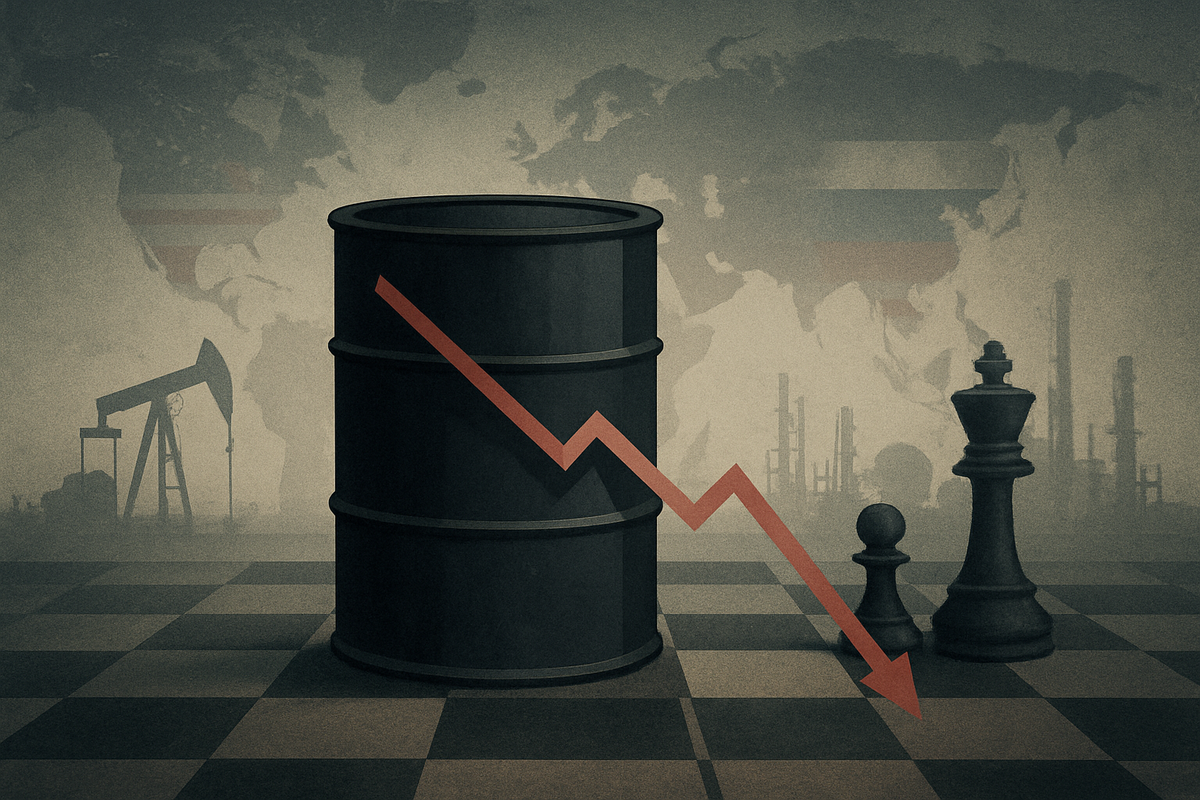
The global financial landscape is currently grappling with a significant downturn in oil prices, a phenomenon that has profound economic and political implications. As of October 31, 2025, Brent crude is trading around $64.49 per barrel, an 11.78% decrease year-on-year, while West Texas Intermediate (WTI) crude hovers around $60.39 per barrel, down 13.09% from the previous year. This sustained decline, which saw Brent crude plummet to a four-year low of approximately $60.00 by May 2025, is not merely a market fluctuation but a complex interplay of supply, demand, and high-stakes geopolitical maneuvering, with political figures like Donald Trump actively leveraging these dynamics for strategic advantage.
The immediate implications of this price slump are multifaceted. For consumers, lower oil prices generally translate to cheaper gasoline, offering a much-needed boost to household purchasing power amidst broader economic anxieties. However, for oil-producing nations and companies, the fiscal strain is considerable, threatening budget stability and investment in future projects. This economic pressure cooker has become fertile ground for political strategies, transforming crude oil from a commodity into a powerful tool in the global political arena.
Unpacking the Barrel: A Detailed Look at the Oil Price Decline
The recent fall in oil prices is a story woven from several threads, starting in late 2024 and intensifying throughout 2025. Brent crude, which began 2025 near $75.00 per barrel, experienced a sharp drop, notably a 13% plunge over two days in early April, pushing it below $67. This trajectory continued, culminating in the current price levels.
The primary drivers behind this downturn are a surge in global supply and a concurrent weakening of demand. Non-OPEC+ countries, particularly the United States, Brazil, Canada, Guyana, and Argentina, have significantly ramped up production, with the U.S. reporting record output of 13.6 million barrels per day (mb/d). Simultaneously, the OPEC+ alliance, after initial cuts, has begun reversing its policy. Between August 2024 and March 2025, the unwinding of cuts contributed to price declines, and in April 2025, OPEC+ unexpectedly announced increased production quotas, adding an estimated 800,000 bpd to global supplies. By October 2025, OPEC+ further increased its quota by 137,000 bpd for the month, signaling a broader strategy to regain market share.
On the demand side, global economic concerns have taken a toll. The U.S. economy contracted by 0.3% in the first quarter of 2025, fueling recession fears. Persistent high interest rates and a generally harsher macroeconomic climate have decelerated oil consumption growth. China's demand, a historical powerhouse, has been particularly sluggish, exacerbated by the rising penetration of electric vehicles (EVs) and broader economic uncertainties. Demand from Japan and China reached a six-month low in October 2025, further depressing prices.
Key players in this unfolding drama include the OPEC+ nations, particularly Saudi Arabia, which has shown a willingness to tolerate lower prices to push for increased output and potentially discipline non-compliant members. Non-OPEC+ producers like the U.S. continue to prioritize domestic production. Politically, figures like Donald Trump have emerged as significant stakeholders, using the market dynamics to further their agendas. Initial market reactions have seen a mixed bag: consumer relief in importing nations, but fiscal tightening in oil-dependent economies and a dampening effect on investment in high-cost shale production.
Navigating the Volatility: Winners and Losers in the Oil Market Shift
The fluctuating oil prices create a distinct landscape of winners and losers across various sectors and economies. Understanding these shifts is crucial for investors and policymakers alike.
On the winning side, consumers globally are experiencing a tangible benefit. Lower crude prices translate directly into reduced costs at the pump, freeing up disposable income and potentially stimulating other areas of the economy. Industries with high fuel consumption, such as airlines (e.g., Delta Air Lines (NYSE: DAL), American Airlines Group (NASDAQ: AAL)), stand to gain significantly from reduced operational costs, potentially boosting profit margins and allowing for more competitive pricing. Furthermore, the persistent volatility and lower prices in the fossil fuel sector appear to be accelerating the energy transition. Companies focused on renewable energy (e.g., NextEra Energy (NYSE: NEE), Brookfield Renewable Partners (NYSE: BEP)) have seen their stocks outperform fossil fuel equities, indicating investor confidence in a decarbonized future as renewables become increasingly cost-competitive.
Conversely, the losers are primarily concentrated in the oil-producing nations and companies. Countries heavily reliant on oil revenues, such as Saudi Arabia and other Gulf States, face considerable fiscal challenges. Saudi Arabia, with an estimated fiscal breakeven oil price around $94 per barrel, could see its budget deficit exceed 5% of GDP if prices remain in the $60-$65 range. This fiscal strain necessitates cuts in government spending and slower growth in non-oil sectors, potentially leading to social and economic instability. U.S. shale producers are also feeling the pinch. Reduced margins due to lower prices dampen the outlook for production investment, making high-cost shale exploration less attractive and potentially leading to cutbacks in future projects and consolidation within the industry. Major integrated oil companies like ExxonMobil (NYSE: XOM) and Chevron (NYSE: CVX), while diversified, will also see impacts on their upstream (exploration and production) segments, potentially affecting capital expenditure and shareholder returns.
Beyond the Barrel: Analyzing the Wider Significance
The fall in oil prices transcends immediate economic impacts, fitting into broader industry trends and carrying significant geopolitical weight. This event underscores a global pivot towards greater energy independence and an accelerated energy transition. The sustained lower prices, coupled with increased non-OPEC+ supply, challenge the traditional market dominance of cartels like OPEC+, potentially leading to a more fragmented and competitive global oil market.
The ripple effects are far-reaching. Fiscal pressures on oil-dependent economies could lead to political instability in regions already prone to unrest, potentially creating new geopolitical flashpoints. Trade policies, particularly those championed by political figures like Donald Trump, are proving to be a powerful, albeit disruptive, factor. Trump's use of tariffs – such as the 25% tariff on steel imports in February 2025 and the 20% blanket tariff on EU imports in April 2025 – is explicitly linked to demands for other nations to purchase American energy products, effectively weaponizing trade to secure energy markets for the U.S. This creates a complex web of regulatory and policy implications, where energy security and economic nationalism intertwine.
Historically, periods of low oil prices have often spurred innovation and efficiency gains, but they have also triggered economic crises in producer nations and geopolitical realignments. The current situation draws parallels to the mid-2010s oil crash, where U.S. shale production surged, challenging OPEC's market share. However, the added layer of explicit trade tariffs and a heightened focus on energy independence, particularly from the U.S., marks a distinct evolution in how these market dynamics are being managed and exploited by political actors. The accelerating pace of electrification and the growing penetration of EVs also suggest a structural shift in demand that was less pronounced in previous downturns, adding another layer of complexity to the current scenario.
The Road Ahead: What Comes Next for the Oil Market
Looking forward, the oil market is poised for continued volatility, driven by an intricate dance between supply adjustments, demand fluctuations, and persistent geopolitical maneuvering. In the short term, attention will remain on OPEC+'s production decisions. While they have increased quotas recently, sustained low prices could prompt renewed discussions about deeper cuts to stabilize the market, although Saudi Arabia's willingness to tolerate lower prices for market share complicates this.
Strategic pivots are already evident. Oil-producing nations are likely to intensify efforts to diversify their economies away from oil dependence, accelerating investments in non-oil sectors and renewable energy projects. Energy companies, particularly those in the U.S. shale patch, may need to adapt by focusing on efficiency, consolidation, and perhaps even a strategic shift towards carbon capture or other energy transition technologies to remain viable. For consumers, the immediate future likely holds continued relief at the pump, but the long-term implications of trade wars and geopolitical tensions could introduce new uncertainties.
Market opportunities may emerge in the renewable energy sector, as investors increasingly favor sustainable alternatives to volatile fossil fuels. Challenges, however, will persist for traditional oil and gas players, especially those with high production costs or significant exposure to politically charged trade routes. Potential scenarios range from a sustained period of low prices, driven by continued oversupply and weak demand, to a rebound if global economic growth accelerates or if major geopolitical events disrupt supply. The ongoing trade disputes, particularly between the U.S. and its trading partners, will continue to cast a shadow over global demand expectations and add to market uncertainty.
The Political Crude: A Comprehensive Wrap-Up
The recent fall in oil prices is a potent reminder of the commodity's enduring role as a central pillar of global economics and geopolitics. It is a complex event shaped by increased non-OPEC+ supply, strategic production adjustments by OPEC+, and a significant deceleration in global demand, particularly from major economies like China and the U.S. The political dimension, prominently featuring figures like Donald Trump, has transformed market dynamics into a strategic battleground. Trump's consistent advocacy for lower oil prices, his aggressive push for domestic production, and his strategic use of tariffs to leverage energy deals underscore how market forces are being actively shaped by political agendas.
Moving forward, the oil market will remain a volatile and politically charged arena. Investors should closely monitor OPEC+ decisions, global economic indicators (especially GDP growth and industrial output from China and the U.S.), and evolving trade policies. Geopolitical events, particularly those involving major oil-producing regions or trade routes, will also continue to be significant market movers. The ongoing energy transition, accelerated by sustained oil price volatility, represents a long-term structural shift that will continue to influence investment decisions and corporate strategies.
Ultimately, the current oil price scenario highlights the intricate interconnectedness of financial markets, political leadership, and global energy security. The "political crude" is not just a phrase but a descriptor of an era where oil prices are as much a function of presidential pronouncements and trade wars as they are of drilling rigs and demand forecasts. The lasting impact will likely be a more diversified global energy landscape, a recalibration of geopolitical power dynamics, and a continued emphasis on energy independence as a national security imperative.
This content is intended for informational purposes only and is not financial advice





